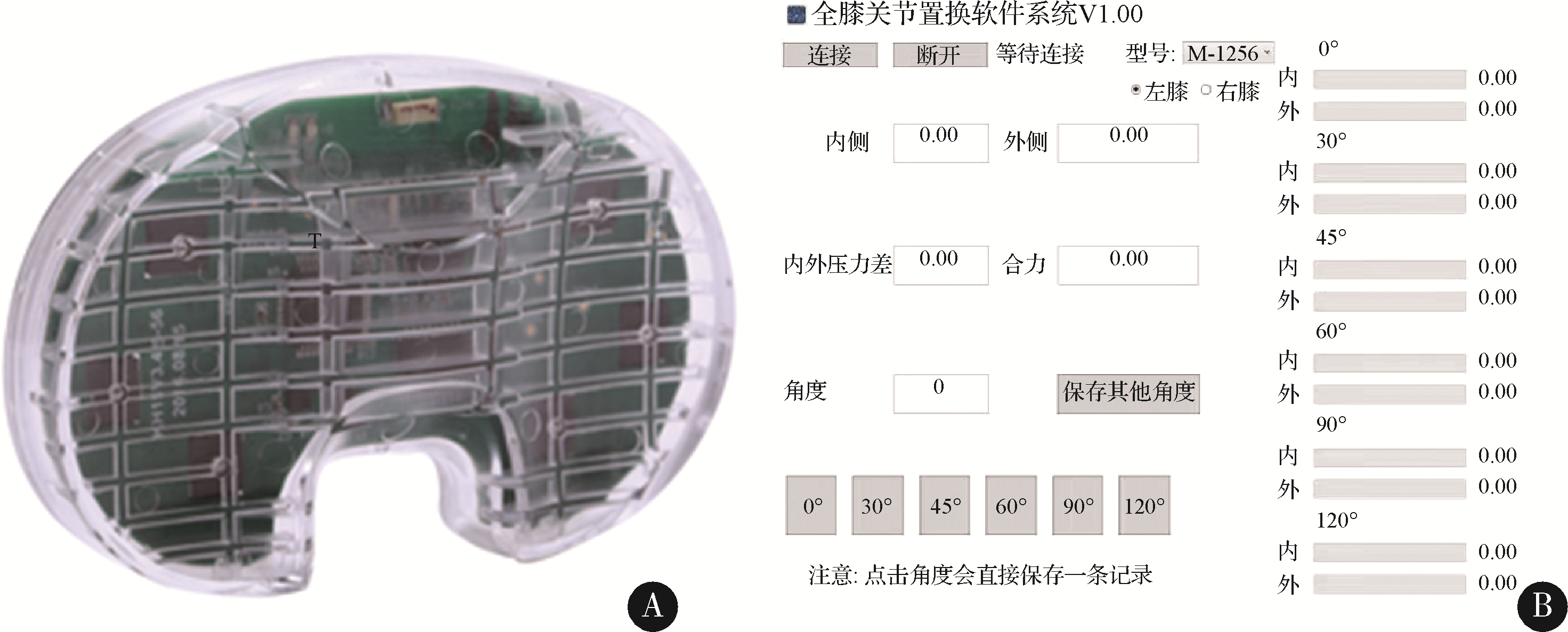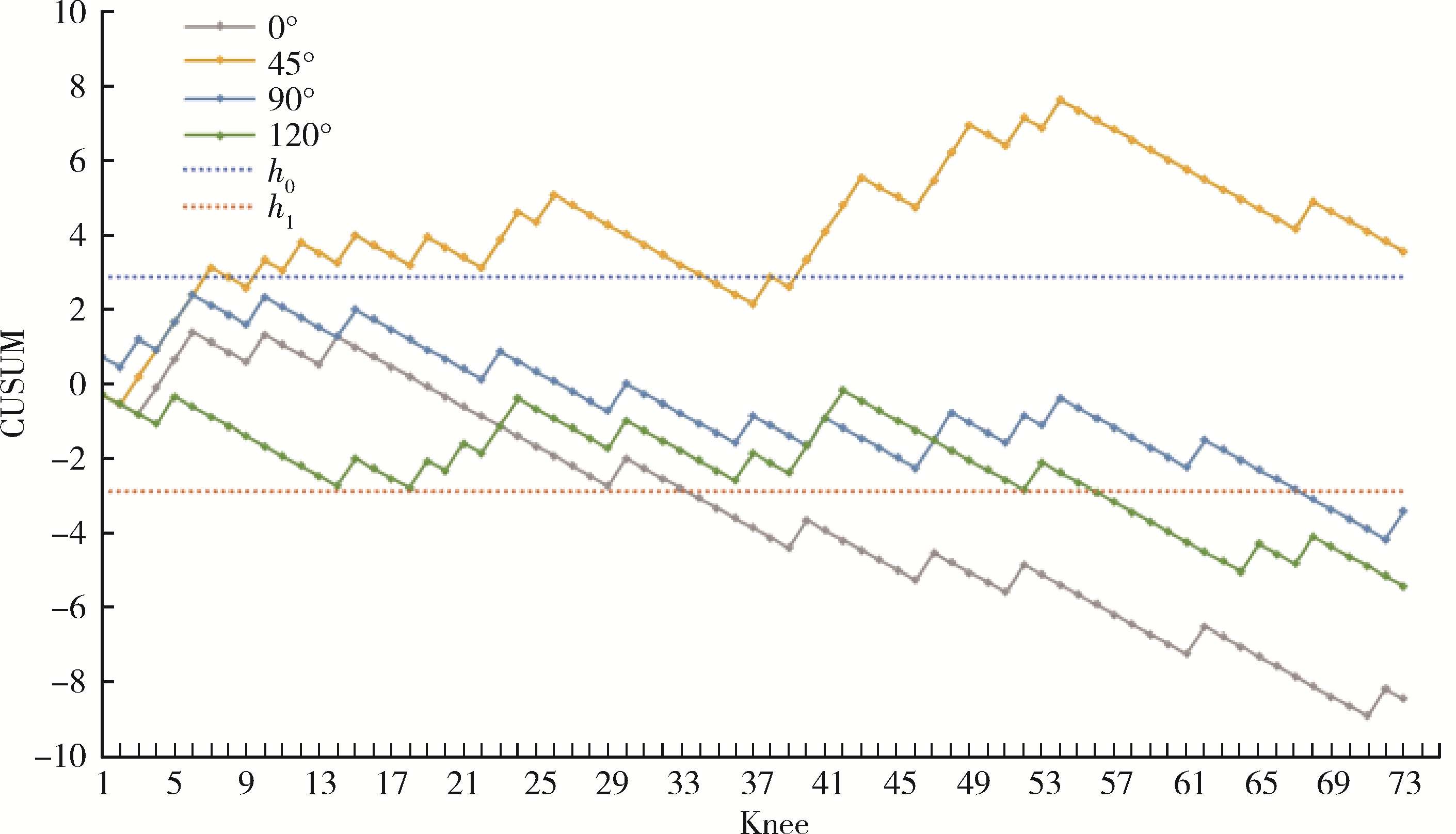北京大学学报(医学版) ›› 2023, Vol. 55 ›› Issue (4): 658-664. doi: 10.19723/j.issn.1671-167X.2023.04.015
应用累积和控制图分析全膝关节置换术中电子压力垫片指导软组织平衡的学习曲线
- 北京大学第三医院骨科,北京 100191
Cumulative sum control chart analysis of soft tissue balance in total knee replacement assisted by electronic pressure sensor
Ran ZHAO,Yan-qing LIU*( ),Hua TIAN*(
),Hua TIAN*( )
)
- Department of Orthopedics, Peking University Third Hospital, Beijing 100191, China
摘要:
目的: 使用累积和(cumulative sum,CUSUM)控制图绘制学习曲线,探讨术者在电子压力垫片(sensor)辅助全膝关节置换术(total knee arthoplasty,TKA)中软组织平衡的学习能力。方法: 回顾性分析一位高年资医师最初完成的73膝sensor辅助TKA数据,其中男性8例(8膝),女性52例(65膝),平均年龄(67.5±5.9)岁(57~82岁)。测量膝关节伸直(0°)和屈曲45°、90°、120°时内外侧间隙平衡情况,了解内外侧压力分布,绘制CUSUM学习曲线。结果: 膝关节0°时内侧压力显著高于外侧(P < 0.01),屈曲后内外侧压力均快速下降,屈曲45°~120°时内外侧压力相似。0°时的学习曲线在第34膝自上而下穿过可接受控制线,表明膝关节伸直位软组织平衡最易通过sensor学习掌握;屈曲45°时的学习曲线始终在不可接受线上方,表明中屈曲角度膝关节平衡最难掌握;屈曲90°和120°时,分别在第68膝和57膝穿过可接受线,表明屈曲及极度屈曲时的软组织平衡技术可经过增加手术例数获得提高。结论: sensor学习过程简单,可以辅助TKA术中的软组织平衡,指导关节外科医师进一步掌握软组织平衡技术。
中图分类号:
- R687.4
| 1 | ElmallahRK,MistryJB,CherianJJ,et al.Can we really "feel" a balanced total knee arthroplasty?[J].J Arthroplasty,2016,31(Suppl 9):102-105. |
| 2 |
GustkeKA,GolladayGJ,RocheMW,et al.Increased satisfaction after total knee replacement using sensor-guided technology[J].Bone Joint J,2014,96-B(10):1333-1338.
doi: 10.1302/0301-620X.96B10.34068 |
| 3 |
BellemansJ,VandenneuckerH,Van LauweJ,et al.A new surgical technique for medial collateral ligament balancing: Multiple needle puncturing[J].J Arthroplasty,2010,25(7):1151-1156.
doi: 10.1016/j.arth.2010.03.007 |
| 4 |
YapCH,ColsonME,WattersDA.Cumulative sum techniques for surgeons: A brief review[J].ANZ J Surg,2007,77(7):583-586.
doi: 10.1111/j.1445-2197.2007.04155.x |
| 5 |
WoonCYL,CarrollKM,LymanS,et al.Dynamic sensor-balanced knee arthroplasty: Can the sensor "train" the surgeon?[J].Arthroplast Today,2019,5(2):202-210.
doi: 10.1016/j.artd.2019.03.001 |
| 6 | CanovasF,DagneauxL.Quality of life after total knee arthroplasty[J].Orthop Traumatol Surg Res,2018,104(Suppl 1):S41-S46. |
| 7 | Van DammeG,DefoortK,DucoulombierY,et al.What should the surgeon aim for when performing computer-assisted total knee arthroplasty?[J].J Bone Joint Surg Am,2005,87(Suppl 2):52-58. |
| 8 |
KhanN,AbboudiH,KhanMS,et al.Measuring the surgical "learning curve": Methods, variables and competency[J].BJU Int,2014,113(3):504-508.
doi: 10.1111/bju.12197 |
| 9 |
RamsayCR,GrantAM,WallaceSA,et al.Assessment of the learning curve in health technologies. A systematic review[[J].Int J Technol Assess Health Care,2000,16(4):1095-1108.
doi: 10.1017/S0266462300103149 |
| 10 |
ZhaoR,LiuY,TianH.Accuracy of soft tissue balancing in total knee arthroplasty using surgeon-defined assessment versus a gap-balancer or electronic sensor[J].J Orthop Surg Res,2021,16(1):305.
doi: 10.1186/s13018-021-02439-w |
| 11 | 孙晓威,张启栋,任鹏鹏,等.全膝关节置换关节间隙压力传感器的研究现状[J].中国矫形外科杂志,2020,28(19):1774-1778. |
| 12 |
GustkeKA,GolladayGJ,RocheMW,et al.A new method for defining balance: Promising short-term clinical outcomes of sensor-guided TKA[J].J Arthroplasty,2014,29(5):955-960.
doi: 10.1016/j.arth.2013.10.020 |
| 13 |
MacDessiSJ,GharaibehMA,HarrisIA.How accurately can soft tissue balance be determined in total knee arthroplasty?[J].J Arthroplasty,2019,34(2):290-294. e1.
doi: 10.1016/j.arth.2018.10.003 |
| 14 |
LakraA,SarpongNO,JenningsEL,et al.The learning curve by operative time for soft tissue balancing in total knee arthroplasty using electronic sensor technology[J].J Arthroplasty,2019,34(3):483-487.
doi: 10.1016/j.arth.2018.11.014 |
| 15 |
MeneghiniRM,Ziemba-DavisMM,LovroLR,et al.Can intra-operative sensors determine the "target" ligament balance? Early outcomes in total knee arthroplasty[J].J Arthroplasty,2016,31(10):2181-2187.
doi: 10.1016/j.arth.2016.03.046 |
| 16 |
VerstraeteMA,MeerePA,SalvadoreG,et al.Contact forces in the tibiofemoral joint from soft tissue tensions: Implications to soft tissue balancing in total knee arthroplasty[J].J Biomech,2017,58,195-202.
doi: 10.1016/j.jbiomech.2017.05.008 |
| 17 |
RocheM,ElsonL,AndersonC.Dynamic soft tissue balancing in total knee arthroplasty[J].Orthop Clin North Am,2014,45(2):157-165.
doi: 10.1016/j.ocl.2013.11.001 |
| 18 |
LeDH,GoodmanSB,MaloneyWJ,et al.Current modes of fai-lure in TKA: Infection, instabi-lity, and stiffness predominate[J].Clin Orthop Relat Res,2014,472(7):2197-2200.
doi: 10.1007/s11999-014-3540-y |
| 19 |
StamboughJB,EdwardsPK,MannenEM,et al.Flexion instabi-lity after total knee arthroplasty[J].J Am Acad Orthop Surg,2019,27(17):642-651.
doi: 10.5435/JAAOS-D-18-00347 |
| 20 |
HinoK,KutsunaT,OonishiY,et al.Assessment of the midfle-xion rotational laxity in posterior-stabilized total knee arthroplasty[J].Knee Surg Sports Traumatol Arthrosc,2017,25(11):3495-3500.
doi: 10.1007/s00167-016-4175-1 |
| 21 | ParratteS,PagnanoMW.Instability after total knee arthroplasty[J].J Bone Joint Surg Am,2008,90(1):184-194. |
| 22 |
VajapeySP,PettitRJ,LiM,et al.Risk factors for mid-flexion instability after total knee arthroplasty: A systematic review[J].J Arthroplasty,2020,35(10):3046-3054.
doi: 10.1016/j.arth.2020.05.026 |
| 23 |
ClaryCW,FitzpatrickCK,MaletskyLP,et al.The influence of total knee arthroplasty geometry on mid-flexion stability: An expe-rimental and finite element study[J].J Biomech,2013,46(7):1351-1357.
doi: 10.1016/j.jbiomech.2013.01.025 |
| 24 |
HinoK,IshimaruM,IsekiY,et al.Mid-flexion laxity is greater after posterior-stabilised total knee replacement than with cruciate-retaining procedures: A computer navigation study[J].Bone Joint J,2013,95-B(4):493-497.
doi: 10.1302/0301-620X.95B4.30664 |
| 25 | EvangelistaPJ,LasterSK,LenzNM,et al.A computer model of mid-flexion instability in a balanced total knee arthroplasty[J].J Arthroplasty,2018,33(Suppl 7):S265-S269. |
| 26 |
LuyckxT,VandenneuckerH,IngLS,et al.Raising the joint line in TKA is associated with mid-flexion laxity: A study in cadaver knees[J].Clin Orthop Relat Res,2018,476(3):601-611.
doi: 10.1007/s11999.0000000000000067 |
| 27 |
MatziolisG,BrodtS,WindischC,et al.The reversed gap technique produces anatomical alignment with less midflexion instability in total knee arthroplasty: A prospective randomized trial[J].Knee Surg Sports Traumatol Arthrosc,2016,24(8):2430-2435.
doi: 10.1007/s00167-015-3798-y |
| 28 |
MochizukiT,TanifujiO,SatoT,et al.Association between anteroposterior laxity in mid-range flexion and subjective healing of instability after total knee arthroplasty[J].Knee Surg Sports Traumatol Arthrosc,2017,25(11):3543-3548.
doi: 10.1007/s00167-016-4375-8 |
| 29 |
BabisGC,TrousdaleRT,MorreyBF.The effectiveness of isolated tibial insert exchange in revision total knee arthroplasty[J].J Bone Joint Surg Am,2002,84(1):64-68.
doi: 10.2106/00004623-200201000-00010 |
| 30 |
AbdelMP,PulidoL,SeversonEP,et al.Stepwise surgical correction of instability in flexion after total knee replacement[J].Bone Joint J,2014,96-B(12):1644-1648.
doi: 10.1302/0301-620X.96B12.34821 |
| 31 |
SchwabJH,HaidukewychGJ,HanssenAD,et al.Flexion instability without dislocation after posterior stabilized total knees[J].Clin Orthop Relat Res,2005,440,96-100.
doi: 10.1097/00003086-200511000-00018 |
| 32 |
LongoUG,CiuffredaM,ManneringN,et al.Outcomes of posterior-stabilized compared with cruciate-retaining total knee arthroplasty[J].J Knee Surg,2018,31(4):321-340.
doi: 10.1055/s-0037-1603902 |
| 33 |
van der LindeJA,BeathKJ,LeongAKL.The reliability of sensor-assisted soft tissue measurements in primary total knee arthroplasty[J].J Arthroplasty,2018,33(8):2502-2505. e12.
doi: 10.1016/j.arth.2018.03.067 |
| [1] | 吴思妤,李娅宁,张晓,吕珑薇,刘云松,叶红强,周永胜. 上颌中切牙全瓷冠牙体预备学习曲线的预测、分析与应用[J]. 北京大学学报(医学版), 2023, 55(1): 108-113. |
| [2] | 刘恒,李卓扬,曹永平,崔云鹏,吴浩. 胫骨侧徒手截骨的膝关节置换术后力线测量及其影响因素分析[J]. 北京大学学报(医学版), 2018, 50(5): 850-854. |
| [3] | 邓莹,姜天乐,杨晓霞,李民,王军,郭向阳. 连续股神经阻滞联合关节周围浸润镇痛对全膝关节置换术后关节早期功能恢复的影响[J]. 北京大学学报(医学版), 2017, 49(1): 137-141. |
| [4] | 刘宁, 黄广林, 满立波, 何峰, 王海东, 王海, 李贵忠, 王建伟. 缩短钬激光前列腺剜除术学习曲线的方法[J]. 北京大学学报(医学版), 2015, 47(4): 720-723. |
| [5] | 柳剑, 吴坚, 窦勇, 吕明, 唐竞, 周一新. 多关节置换术患者的生活质量评估[J]. 北京大学学报(医学版), 2015, 47(2): 285-288. |
| [6] | 褚亚明, 窦勇, 李玉军, 周一新△. 人工膝关节置换术后小腿深静脉血栓的转归[J]. 北京大学学报(医学版), 2013, 45(5): 708-710. |
| [7] | 张树栋,马潞林,黄毅,庄申榕,邱敏,毕海,廖文峰. 经脐单孔腹腔镜肾切除术的技术改进[J]. 北京大学学报(医学版), 2013, 45(4): 579-. |
| [8] | 朱丰, 胡焱, 张伟. 连续股神经阻滞置管长度对股神经、股外侧皮神经和闭孔神经阻滞效果的影响[J]. 北京大学学报(医学版), 2013, 45(1): 145-148. |
| [9] | 刘恒, 文立成, 曹永平, 杨昕, 叶一林, 张道俭. 膝关节置换术后切口周围皮肤麻木的研究[J]. 北京大学学报(医学版), 2012, 44(6): 882-886. |
| [10] | 郑卫, 吴鑫, 张雷, 宋刚, 张争, 龚侃, 宋毅, 李学松, 何志嵩, 周利群. 腹腔镜膀胱全切手术:单中心60例学习曲线结果分析[J]. 北京大学学报(医学版), 2012, 44(4): 558-562. |
| [11] | 熊建, 付中国, 张殿英, 姜保国, 王天兵, 徐海林, 薛峰, 陈建海, 党育, 张培训, 杨明. 微创内固定稳定系统治疗全膝关节置换术后股骨髁上假体周围骨折[J]. 北京大学学报(医学版), 2011, 43(5): 714-717. |
| [12] | 裴征, 关振鹏, 张绍龙, 李云鹏, 张卓. 重度膝内翻伴骨缺损的全膝表面置换术中的自体骨移植治疗[J]. 北京大学学报(医学版), 2011, 43(5): 707-713. |
|
||






